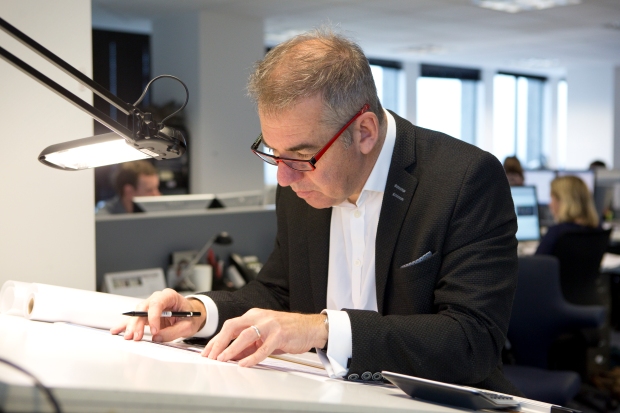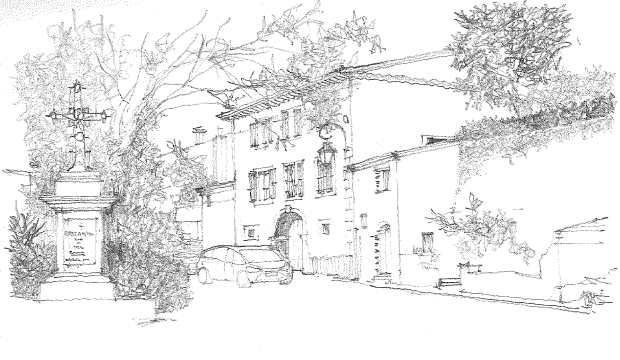(…when computers can draw almost anything these days!)
Our Managing Director, Alan, is a passionate proponent of sketching. In the office, he’s often found at his drawing board, and he’s even got his sketch pad out when he’s on holiday! We asked him why he thinks sketching and hand drawing is such an important skill for an architect to use.

- Alan’s holiday sketch of Paxos
What if you can’t draw?
Sketching is a skill we can all learn- we aren’t born with it, we need to develop it through training and practise. Like music. OK, some people will never become international musicians, but we can all be reasonably good. We can all be Bananarama, if not Tchaikovsky. We can all be trained to sketch and paint. Join a class if you don’t believe me and you’ll see the difference in just a few days.
Isn’t it easier to just take a photograph?
Well, when we draw by hand, we look at things differently and certainly in more detail. I can stroll through town and think I know how it works and how it’s put together. Sure, I can take photographs to record what I think I see, but it’s interesting when I refer to those photos again in the office- that lamppost is obscuring the one detail of a distant building that’s important in our scheme!! How didn’t I see that when I photographed it?!
Well, if I had started to sketch it, I would have realised my error quickly, and started the sketch from a different position. That’s because when I draw by hand, from life, I look at things more intently. I have to, or else it doesn’t come together. I can’t get that cornice to line up with that window head accurately; I can’t get the perspective working properly. So I look more closely; it all counts.
Drawing also gives you thinking time. And often, as a result of taking your time, your understanding of a place changes as you draw. You thought it was a suburban context, but actually it is a subrural one! That in turn, changes a lot- how the roads work; how they are edged; the degree of soft and hard.

One of our directors, Gavin, at his drawing board
How detailed do my sketches need to be?
To get the most benefit I need to sketch quickly. That means setting out the horizon, setting out the vanishing point(s) and dealing with the whole image at once, working down into the detail only when you know the composition is right. Drawing quickly helps enormously, as it gives you lots of time to correct yourself. Try drawing the scene in front of you but limit yourself to 120 seconds. Very tough at first, but gets easier. When you’ve started to get the hang of that, you can start to develop quick representations of existing places, then add detail, and then it takes only a short step to develop the skills to represent unbuilt places. Sketches can be highly detailed, or entirely simplistic. Which, depends on their purpose, but they are both valid and useful.
Why not just use computer?
You can cheat on computer – use the detail you used last time, copied from another project. There is a time and place for the computer of course, and though these days it begins quite early on in the process, but that doesn’t rule out the early thinking and site character drawings and it doesn’t stop us exploring new ways of joining materials together, by hand, throughout the project.
And of course, when you sketch by hand, you start to understand not just the form, but the mood of the place. We can develop buildings and places very quickly on computers, but how quickly can we capture the character of that place? And great architecture doesn’t exist without some kind of special character.

- Alan’s sketch captures the character of Béziers, France
Drawing helps us think not just about the form of things, but also about light and shade, materials and textures, perspectives and viewpoints. It does this, because you can’t draw it accurately without understanding all those things and more. You have to check whether that window reveal is inset or not, whether walls are dominant or subservient.
Also, drawing helps you explain something quickly to a client or user. There wouldn’t be time in a progress meeting to set up the computer to do that, but a 2B pencil and a sheet of A3 and there you go. It appears in front of the client’s eyes and they are in it with you. And you can draw again over the top of it; how messy it is doesn’t matter, because the client will have understood the evolution of the idea. The fastest computer in the land can’t move as quickly as our brain, but a 2B pencil isn’t far behind!
And of course, it’s all very enjoyable! What would you rather be doing- sketching and working out ideas quickly, or waiting for the laptop to fire up? It’s a no-brainer, so get practicing.
